Climate change has brought turbulence to our natural seasons and we can clearly see the impact on our street trees. The hottest ever September in England delayed the onset of autumn 2023 by weeks, but almost as soon as the leaves had finally changed colour a series of violent storms blew in to strip them away. December was very mild again, but the new year brought bitter cold and more fierce storms.
The trees are now dormant, of course, and riding out the harsh weather, but as the days lengthen water and nutrients will start to flow through the branches again and the buds will begin to swell. In just a few short weeks the growth cycle will resume as the first foliage and flowers of spring emerge.
Even without blossom or leaves, there's still a lot to see if you look closely at trees in winter, and just their twiggy shapes in twilight can teach you a lot. But before we go there let's briefly remind ourselves of the richness of our short, but still spectacular, autumn.
Autumn gallery
Everyone's getting familiar with storm names these days, and between them Babet, Ciaran and Debi dominated the weather reports between late October and mid-November. The sturdy young wild cherry (Prunus avium) at 30-32 Ruskin Walk was virtually bare by November 13, and at the bottom of the road the pavement was carpeted with leaves from the London planes (Platanus x hispanica) of Half Moon Lane.
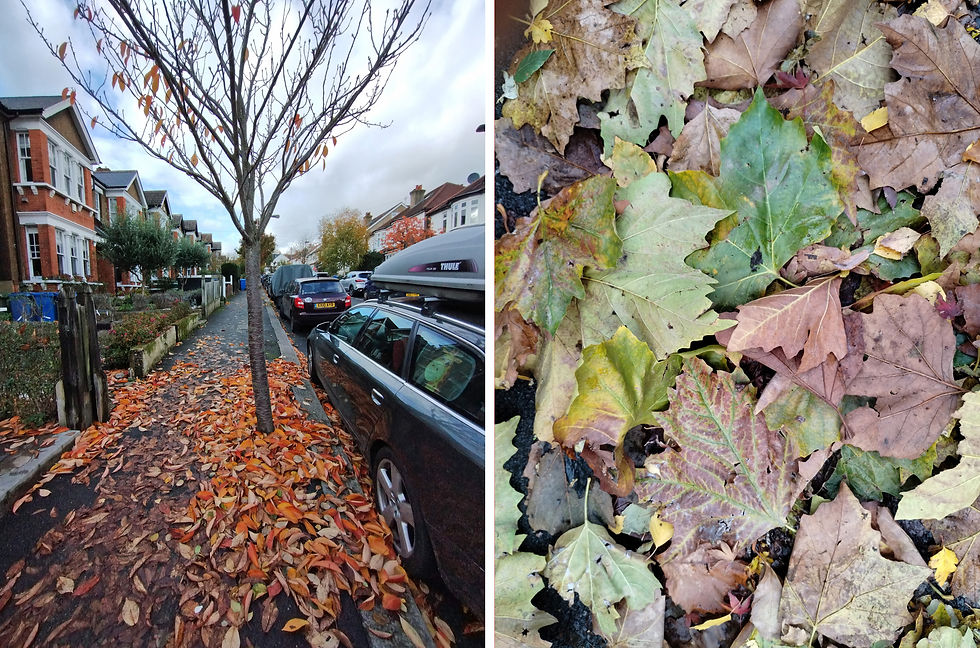
In fact, if you kept your head down you'd probably learn more about common leaf shapes by studying the ground at your feet than by craning your neck to look up. These tulip tree (Liriodendron tulipifera) leaves on Howletts Road highlighted their remarkable shape and warm autumn tints, while on Burbage Road the five-fingered leaves of the American sweet gum (Liquidambar styraciflua) and the lemon-coloured leaves of the wild cherry both stood out.
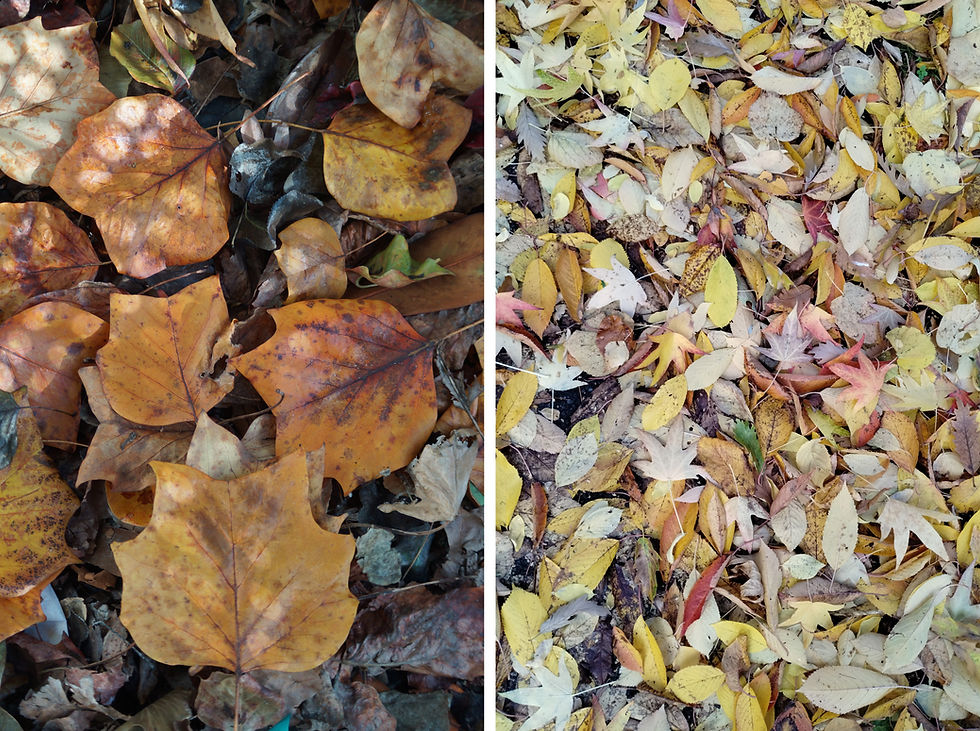
The sweet gums actually withstood the strong winds better than other species and as always made the boldest statement. A single sweet gum can often carry leaves in multiple colours at the same time - red, yellow, orange, purple and burgundy - but perhaps the most vivid trees are the pure crimsons, like the one below at 105 Burbage.
The toughest survivor, though, in the most unforgiving environment was the liquidambar on the traffic island at the Herne Hill junction, directly opposite Hotline Pizza. It stubbornly held on to its leaves right up to Christmas Day.
And if you went right up to any of these sweet gums you'd see, dotted among the brilliant leaves, the curious spiky fruits from the previous spring and summer, which will stay on the tree until a fresh green crop appears in few months.
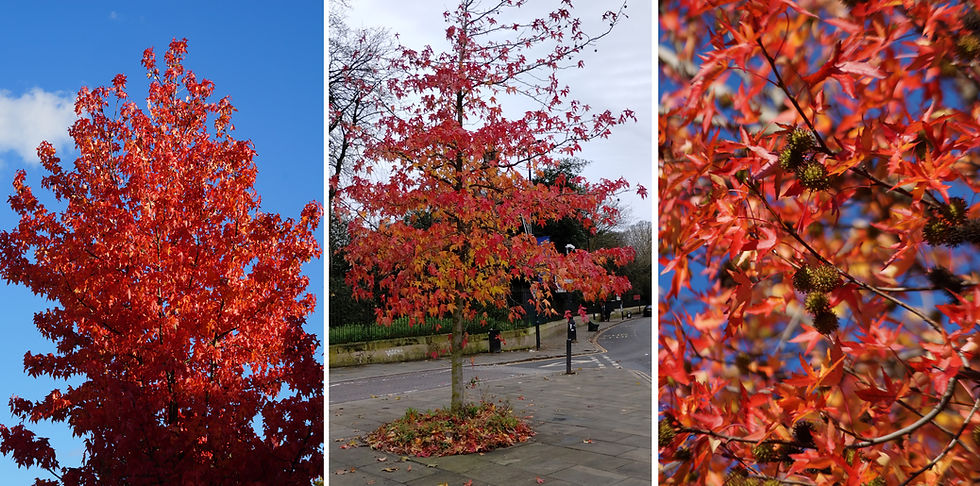
Liquidambars work best for autumn impact when they're in a group, like this pair at 96-98 Burbage (the one in the foreground) and no. 84, pictured on November 4.

They can make any modest urban street look like a mini-forest, like this group of three on Howletts, also shown in early November when they were still partly green.
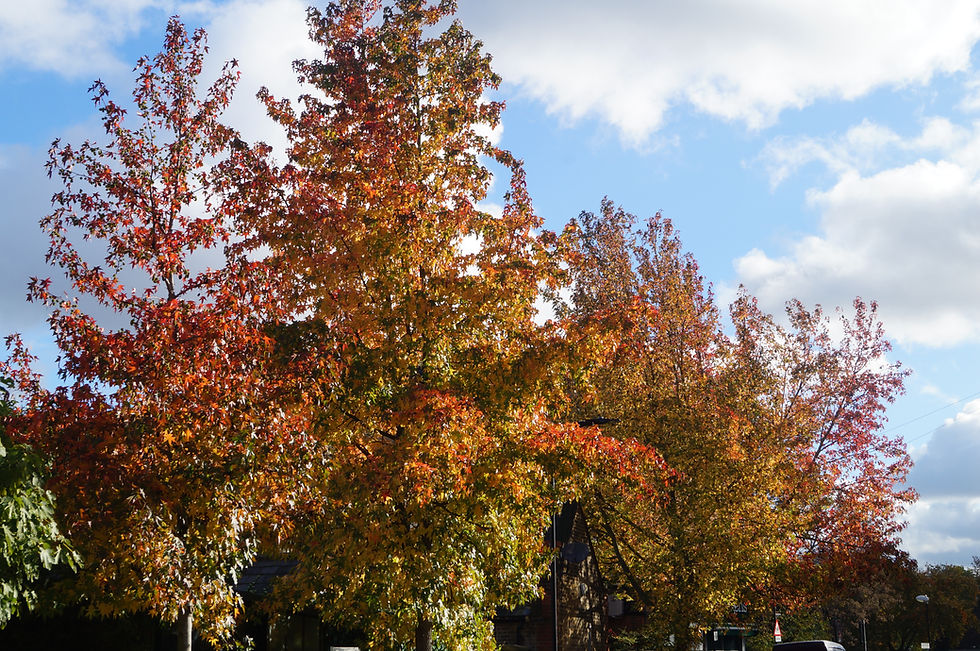
On a more modest scale, Delawyk Crescent has some fine trees that colour beautifully in autumn. The little sweet gum on the front lawn of the estate, nearest to house no. 56a, was almost as bright in mid-November as the Half Moon Lane postbox just behind it. With a small tree like this you can get much closer to the stunning leaves than you can with one of our tall sweet gums.
A few yards further on towards Budgens, outside no. 60a, is Herne Hill's only English walnut (Juglans regia), a muted yellow in the low afternoon sun. The dark yew trees nearby add a more sombre note, but the poisonous red berries hang on amid dark green needles until late in the year.

Here's another pair of underrated trees: the Japanese zelkovas (Zelkova serrata) of Red Post Hill. These two were planted in August 2021 on the stretch between Sunray Gardens and Ardbeg Road and looked stunning in the autumn. Curiously, the one outside no 42-44 turned red but at no. 54 the leaves were yellow. Also known as keakis, zelkovas are native to East Asia and have similar-looking serrated leaves to the related elms. There's not much sun here in November, so the pictures are a bit muted.

The tall ginkgo trees (Ginkgo biloba) on Burbage Road get a lot more sunlight and glow a rich buttery-yellow in autumn. Ginkgos are an extraordinary survivor of primitive seed-bearing plants quite different to our contemporary trees and can be found in Jurassic-era fossils from 260 million years ago. The ribbed, fan-shaped leaves are unlike those on any other tree, and in young ginkgos, like the one below at 5 Burbage, the profile is very geometrical, with an exactly perpendicular central leader and limbs rising at a regular angle. In the winter you can spot the fat, stubby buds arranged in dead straight lines along the branches.
As they age, though, ginkgos get broader and bushier in outline and eventually grow very large. The biggest, in South Korea, measures 42 metres, and even in Yorkshire there's one standing 28 metres high.
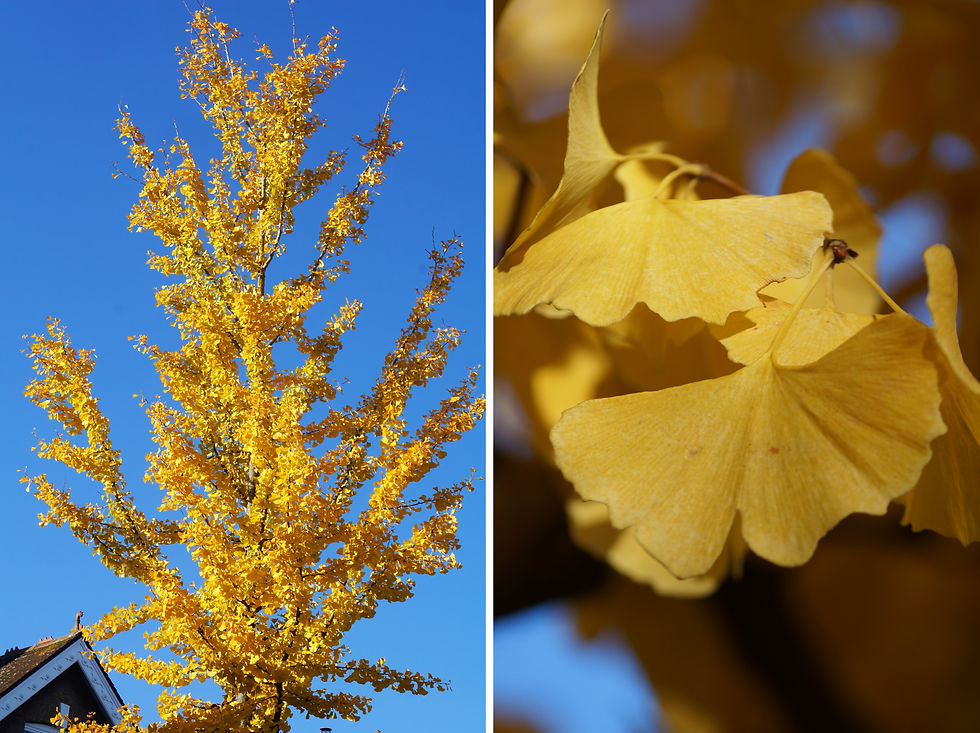
Of course there are other big trees in Herne Hill that look impressive in autumn, even if they don't catch your eye like the ginkgos. The old Turkey oak (Quercus cerris) at the corner of the big green space on Sunray Avenue, by the junction with Nairne Grove, looked warmly pleasing in early November. You might also know the enormous Turkey oak in Dulwich Park, on the boundary road near the tennis courts.
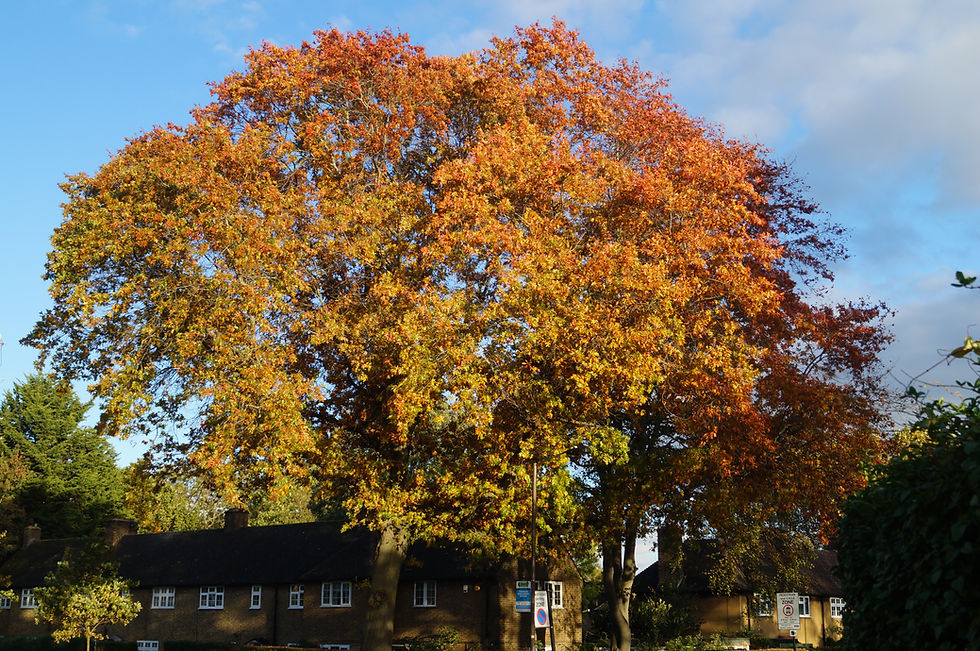
Over on Beckwith Road, meanwhile, the tall tulip tree (Liriodendron tulipifera) outside no. 60 was well into its bright autumn display while all the trees around it were still green.
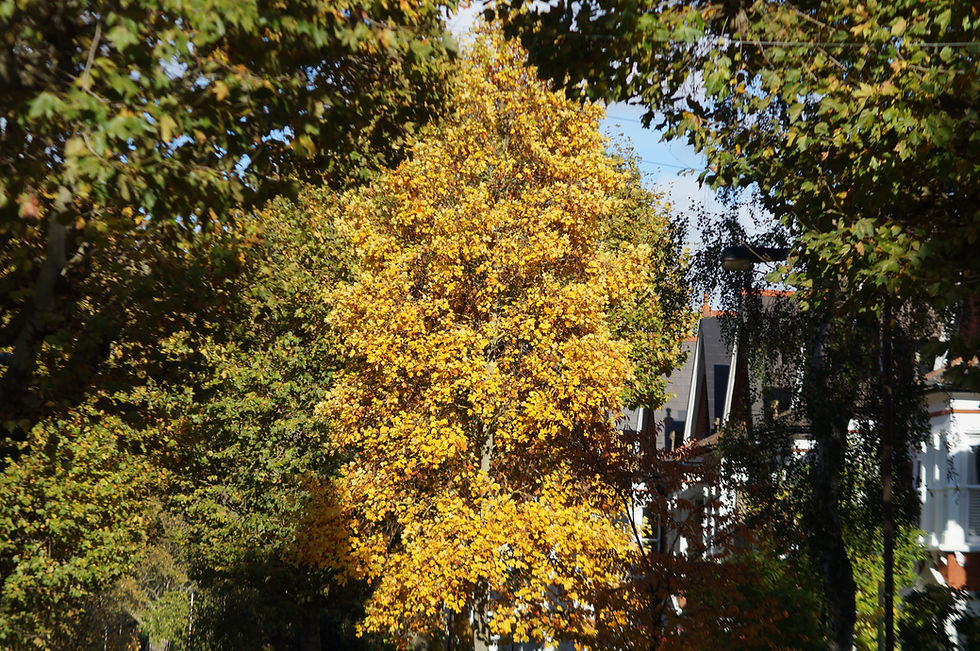
The birches had a good autumn, clinging on to their yellow leaves until December. This stately silver birch (Betula pendula) at 74 Ruskin Wal, looked very fine, as did the many pure white-stemmed Himalayan birches (Betula utilis jacquemontii) along our streets. Another of our very familiar trees, the chanticleer pear (Pyrus calleryana 'Chanticleer'), also performed well this season. You can see the chanticleer's red, yellow and orange foliage at 68 Ruskin, behind the silver birch.

One tree you might have overlooked is the unusual smooth-leaved elm (Ulmus carpinifolia) on Half Moon Lane, outside the Baptist Church, with its yellow and brown autumn foliage, pictured below. The carpinifolia in its name means 'leaves like a hornbeam' (Carpinus), although it's more commonly called Ulmus minor nowadays. The serrated leaves of the elm could indeed be mistaken for a hornbeam, with one big difference: like all elms, the leaves of the smooth leaved-elm are asymmetrical, with an extra bulge on one side where the stalk meets the leaf.
The smooth-leaved elm has some resistance to Dutch elm disease, but it's particularly useful in an urban context because it can withstand both pollution and salt spray. It originated in southern Europe and North Africa, but has become naturalised - in other words, it grows wild - in the countryside of southern England, where it's known as the field elm.
There's a true native a few yards away from the elm, inside the church grounds: the big oak on the corner of Winterbrook Road. Its straight trunk makes it look more like a Quercus petraea (sessile oak) than a squat Quercus robur (English oak), but the only sure way of distinguishing our two traditional woodland oaks is by looking at their acorns. On the English oak the acorns hang down on stalks, while on the sessile oak they have no stalks and sit up among the leaves.
Checking acorns in autumn 2023 wasn't an option for the simple reason that there weren't actually any to look at. This and other oaks in the neighbourhood were recovering from producing a big crop of acorns the previous season - what's known as a 'mast year'.

The leaf pictured next to the elm comes from the Turkish hazel (Corylus colurna) growing on the road build-out at the junction of Beckwith and Red Post Hill. It's one of four of these interesting trees in Herne Hill (the others are on Casino Avenue, Danecroft Road and Holmdene Avenue). Their bark is rough and rugged, their catkins hang from winter to spring, their nuts emerge from frilly green cases in late summer and their leaves transition from green to yellow in October/November.
The final late autumn tree that we're showcasing is one of our absolute favourites: the broad-leaved cockspur thorn (Crataegus x prunifolia). Unlike most Crataegus (hawthorns), which grow untidily, these little trees have an elegant, neatly layered form. They're covered in bee-friendly blossom in spring, glossy dark green leaves in summer and bright scarlet berries, or haws, in the autumn, when the leaves turn a glorious yellow and brown. It's called prunifolia - which means 'leaves like a Prunus', in other words a cherry, plum or almond - to distinguish the foliage from a common native hawthorn (Crataegus monogyna).
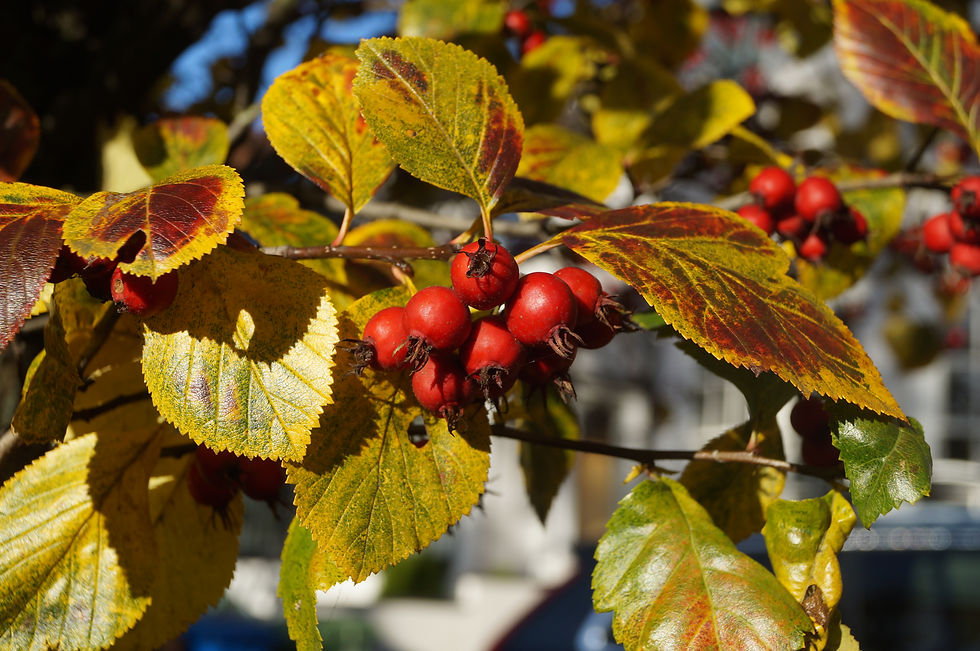
Prior to the 2022/23 planting season there were only three prunifolia in Herne Hill - this one and two others in the top cul-de-sac on Casino. But then the council planted another six on the residential streets, including one outside 6 Warmington Road. By early December the Warmington tree had lost every leaf and all it had to show against a leaden sky was bare twigs dripping with rain and a menacing array of thorns.
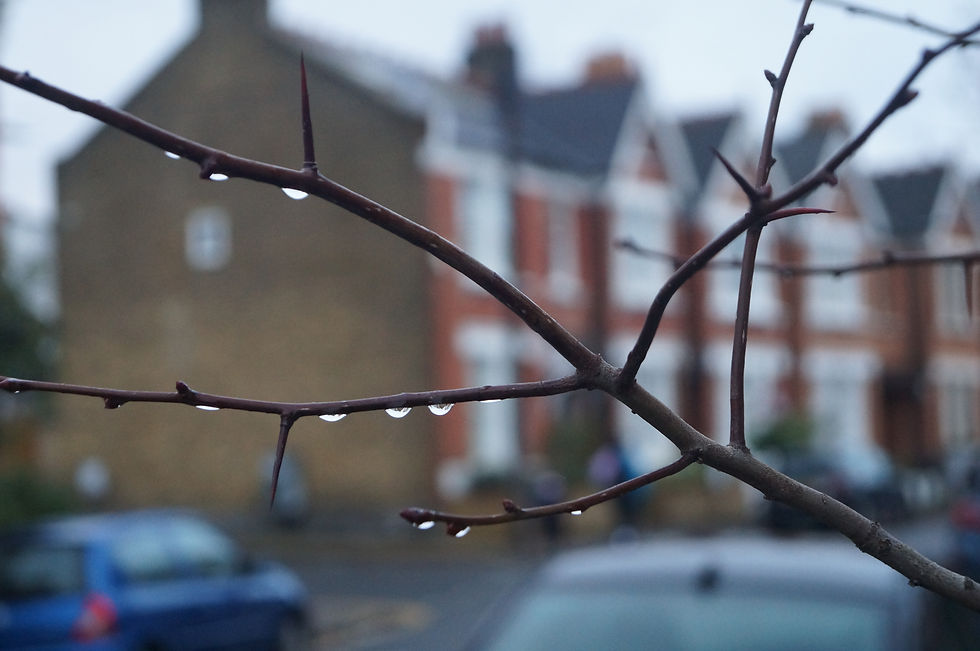
Winter gallery
In wintertime, with no green leaves or colourful flowers to guide you, there are other characteristics that can help you identify street trees, like buds, bark and even long-lasting fruit. Two years ago we published a couple of blogs listing the winter features of some of our commonest trees, species by species. In January 2022 we looked at cherries, apples, pears, hawthorns, birches, hazels, magnolias and tulip trees. And in February 2022 if was the turn of the sweet gums, ginkgos, pagoda trees, limes, London planes, whitebeams, hornbeams and horse chestnuts.
This time round we're taking a different approach to observing trees in winter: grouping them by shared features. For example, which trees hold on to their crinkly brown leaves right through to spring? Which trees have clusters of buds at their ends of their twigs? And which trees are narrow, with upright branches?
Persistent leaves
There are three trees whose leaves stay on the trees throughout the winter: the beeches (Fagus), the hornbeams (Carpinus) and the oaks (Quercus). We don't have many beech trees in Herne Hill, apart from the Zlatia beech (Fagus sylvatica 'Zlatia') planted in March 2023 on Sunray Avenue, over the road from house no. 2b, and a young upright beech at the far end of Nairne Grove that we'll talk about later. But we do have beech hedges in the cul-de-sacs of Casino and Sunray which are attractive all year round. Here's a detail from the native common beech (Fagus sylvatica) hedge outside 34-40 Sunray.
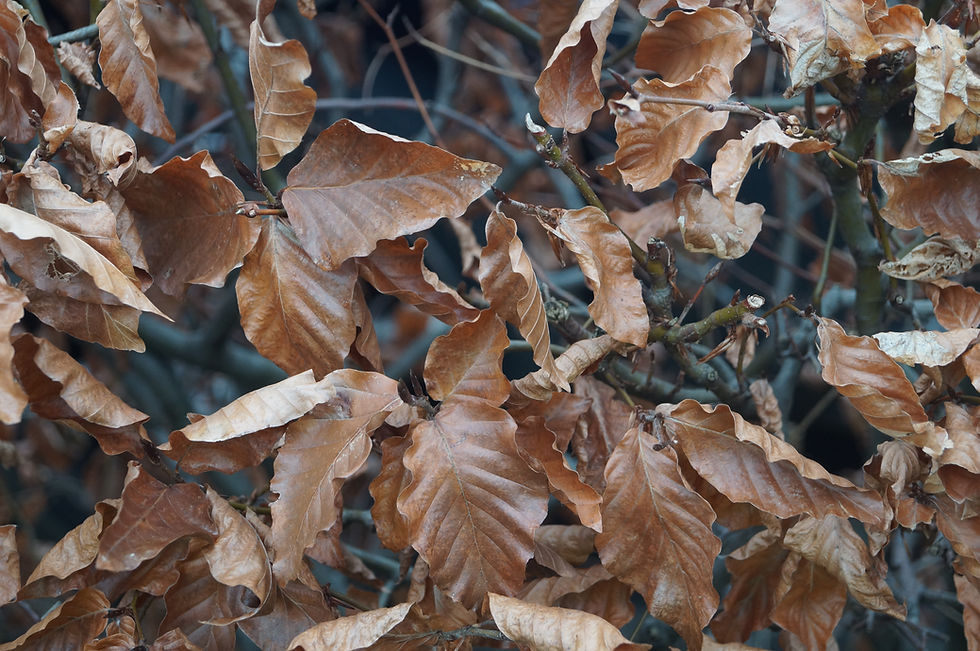
If you look closely among the leaves you'll see the elegant, long, narrow and sharply pointed buds of the beech, wrapped in their brown scales. These grow up to 2 cm long and are a key identifying mark of the tree.

We're lucky to have a lot of common hornbeams (Carpinus betulus) in Herne Hill and Dulwich village, among them this hedge (below) at 33-45 Casino. In summer the green leaves can easily be mistaken for beech, except that in the hornbeam they're serrated around the edges. And in winter they're tightly furled, while the leaves of the beech stay relatively flat. It's hard to spot the hornbeam buds among the tangle of leaves and twigs, but over on Danecroft Road, opposite no. 3, there's a young hornbeam, planted in December 2022, where you can pick them out easily. They're very similar to beech buds, delicate and pointed but only about a third as long.
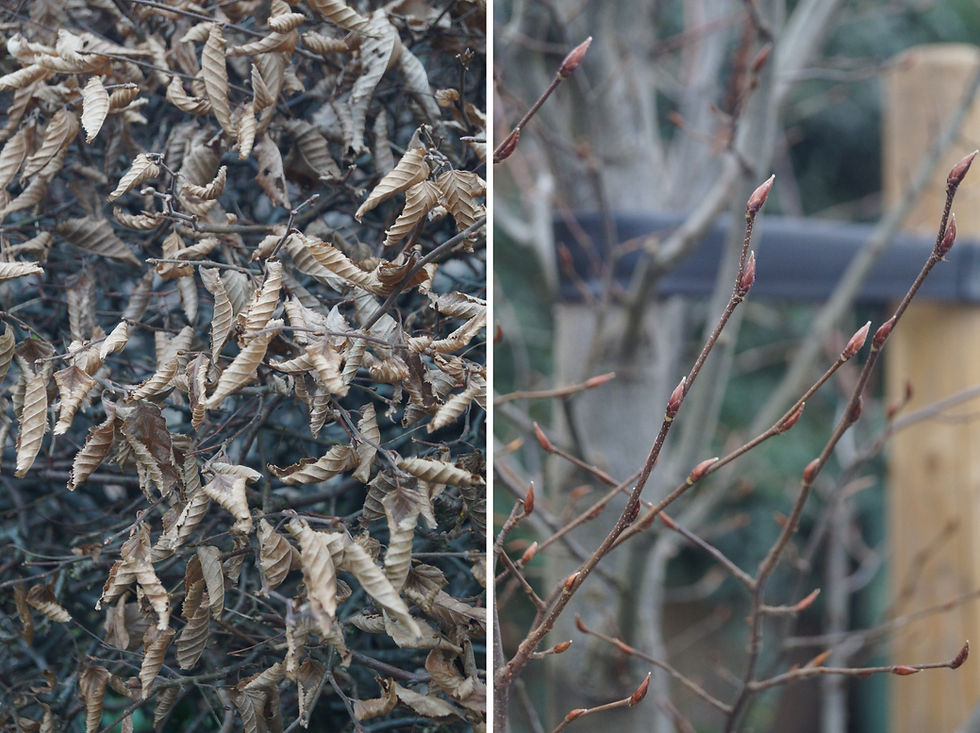
Finally, the enduring leaves of the oaks. The big red-brown leaves In the first photo below sprouted from the stump of the great Northern red oak (Quercus rubra) that stood in front of the Hillcrest estate on Sunray Avenue until October 2022, when it was felled because of decay. Last March the council planted a replacement red oak behind the stump and a chestnut-leaved oak (Quercus castaneifolia) close by.
In the right-hand picture there's a real curiosity: the deeply lobed nut-brown leaves of a small, shrubby Turkey oak in the stone roadside planter outside 87 Red Post Hill. It's hard to imagine this would have been intentionally planted in such a restricted space, and it's much more likely that a squirrel or jay planted an acorn here from the big Turkey oak on Sunray Avenue that we looked at earlier. Of course you'd never see the amazing detail of the leaves looking up into a tall tree, so it's a real pleasure to be able to admire them so close up.

It's not known exactly why this group of trees keep their leaves on for so long. Admittedly the beeches and oaks are from the same botanical family (the Fagaceae), but the catkin-bearing hornbeams belong to the quite separate Betulaceae, which also takes in the birches, alders and hazels. Woodlands.co.uk has an explanation to do with the maturity of the branches, while Northern Woodlands, based in New Hampshire, gives an American viewpoint.
Bud clusters
Interestingly, oaks share a winter speciality with the totally unrelated cherries: their terminal buds (those at the end of a twig or branch) form in clusters. Here's a small Cypress oak (Quercus robur 'fastigiata Koster') outside 112 Casino, on the corner of Red Post Hill, with its clumps of small red buds. Planted in December 2022, it's a narrow, columnar version of the native English oak (Quercus robur). There's an older specimen on Elmwood Road, planted in April 2020 where it joins Beckwith Road and Half Moon Lane.
On the right you can see the bud clusters on one of our many Yoshino cherries (Prunus x yedoensis). This tree, one of a pair on Hollingbourne Road, is at no. 25. Other species of cherry on our streets have the same arrangement.

Winter fruit and flowers
Of course fruit doesn't actually grow in the dormant winter season, but a lot of it hangs on for months up in the branches. You're bound to have seen the spiky fruit of the sweet gums all over Herne Hill, but as the gorgeous autumn leaves fade away it becomes much more visible. The seeds are dispersed in September and as the shell ages it turns from bright green to blackish-brown, the soft tendrils of summer becoming prickly in winter.
The photo below, taken on a dark December afternoon, shows a branch from the broad and handsome sweet gum at 63 Half Moon Lane. Just a few weeks later it was heavily pruned all over and now it looks sadly diminished.
Last year's sweet gum balls will gradually be shed, but many will stay on the tree even after the new green crop has emerged in spring. We've never heard any complaints about them littering the pavements, but in the United States, where liquidambars were popularised, they're considered a major nuisance.

Here's a winter silhouette of another sweet gum decked with old fruit, this time the younger, narrower tree by the car park adjacent to no. 2 Stradella. And next to it is another reminder of the summer of 2023: the dried-out samaras of the Norway maple (Acer platanoides) at 39 Casino, in the top cul-de-sac. Strictly speaking these double-winged fruits should have dropped and flown away from the parent tree in autumn, each distributing its pair of seeds to grow elsewhere.

The fruit of the magnificent tulip tree (Liriodendron tulipifera) is also a collection of samaras, but very different in appearance from the Norway maple. It develops from the beautiful but sparse flowers that dot the high branches in June. Like its close relative the magnolia, and the ginkgo too, the tulip tree is a relatively primitive type and its fruit and leaves are unique. This photo, taken at 46-48 Stradella, shows the fruit largely intact, with the tightly bunched seed-bearing samaras pointing skywards, but as the winter progresses these will fall away one by one, leaving just a central spike.
The catkins on the Turkish hazel outside 7 Casino aren't fruit, of course, but male flowers that will decorate the tree all winter, growing to as much as 12 cm long. They'll eventually fertilise the much smaller and less conspicuous female catkins, which in eight or nine months' time will become ripe hazelnuts.

Here are two other trees that carry their fruit well into winter. The first is a species that we come back to every year to admire its gorgeous crop of brilliant red berries: the
Grignon’s thorn (Crataegus x grignonensis). It's a rarity on London's streets, but Ruskin Walk has three of them, including this one at no. 79. It's a marvel in April, when the white blossom grows among the fruit, looking like a Christmas card of snow and holly berries.
There's another trio of unusual trees with persistent fruit on Danecroft Road: upright bastard service trees (Sorbus x thuringiaca 'Fastigiata') planted by Southwark in December 2022. The tree pictured is at no. 74. The Sorbus genus includes whitebeams, service trees and rowans (or mountain ash) and they naturally cross with each other, producing many micro-species in the wild. That explains the disapproving 'bastard' in the name: the illegitimate child of a whitebeam (Sorbus aria) and a mountain ash (Sorbus aucuparia).

Now we go on to a tree that deserves to be much more widely planted in Herne Hill, for reasons that will become apparent. It's another hawthorn, the Crataegus x lavallei or hybrid cockspur thorn. Its white flowers appear in June, a month later than its cousins, it's armed with stout and sharp thorns, and the dark green glossy leaves stay on the tree almost until the end of the year. But its hallmark is the large orange-red fruit that lasts until the middle of winter. They look just like plum tomatoes.
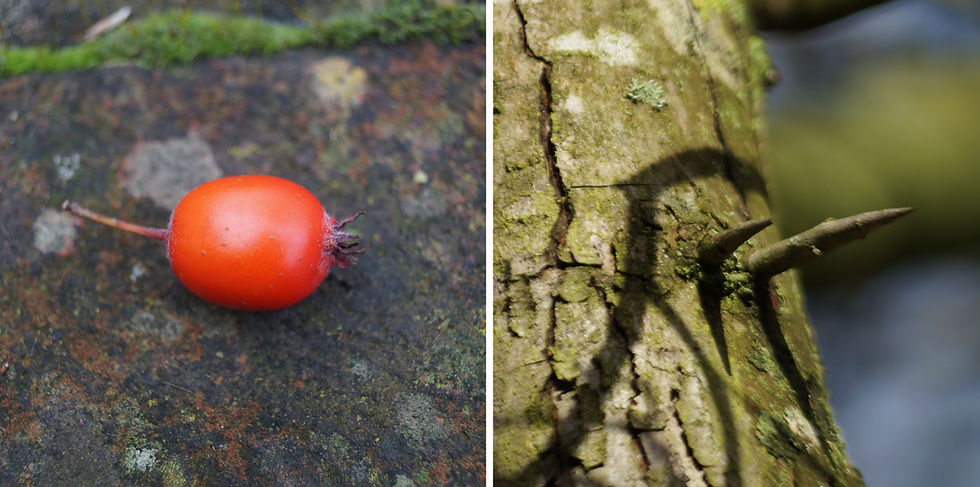
These pictures show the large and shapely tree lavallei at 16-18 Stradella on December 23. Ten days later, on January 2 it was sadly gone, blown down by the powerful winds of Storm Henk. We had another storm victim in the night of January 21-22 when Storm Isha: was the Chinese privet (Ligustrum lucidum) outside 27 Herne Hill, at the top of Casino,
The loss of the hawthorn was a particular blow for the people of Stradella. Only a short time earlier, on the same stretch of road, the double-stemmed grey alder (Alnus incana) at no. 44 had come down too, felled by the council.
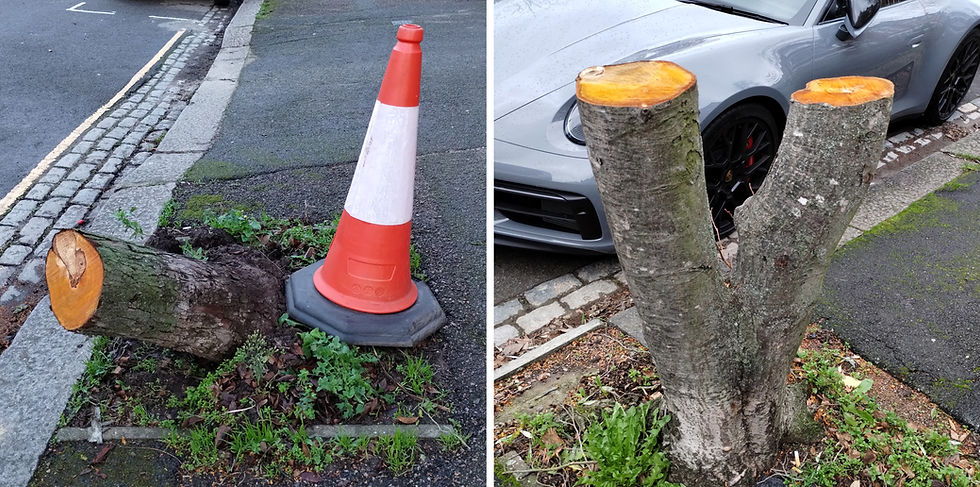
This double disaster left Herne Hill with just a single hybrid cockspur thorn, the one at 19 Hollingbourne. We've pictured this smaller tree previously, most recently last autumn, showing off its prolific fruit against a clear blue sky. Some of the berries are still there.
Perhaps we can persuade the tree officers to plant at least a couple more lavallei in the neighbourhood, if not this season then in 2024/25. As W J Bean's monumental Trees and Shrubs Hardy in the British Isles declares, "It is one of the handsomest of all thorns, either in foliage, flower or fruit."
As for its origin, it's a cross between the cockspur thorn (Crataegus crus-galli), a native of North America with exceptionally long thorns, and the Crataegus stipulacea from Mexico, which bears yellow fruit. It was named in honour of the French dendrologist (tree scientist) Pierre Alphonse Martin Lavallée.
Winter silhouettes
Another of the virtues of the lavallei hawthorn is its 'habit', or characteristic form. To describe a tree's habit you might ask yourself questions like these:
how thick are the branches?
what angle do they grow at?
do they have a central leader (a dominant vertical branch)?
do they spread or weep?
are they fastigiate (strongly ascending) or columnar (like an upright pillar)?
are the buds or shoots in pairs on either side of the stem? They're known as 'opposite' buds and you'll see them on maples and horse chestnuts
or is there just one bud at a time and then another a little further along, alternately facing left and right? Those are 'alternate' bugs, as on cherries and hawthorns.
When a tree is cloaked in leaves the habit might not be immediately obvious, but in wintertime it's all you'll see - especially when the sun begins to set.
Our big hybrid cockspur thorn on Stradella, now sadly departed, had a lovely, graceful habit, its tightly packed twigs and branches gently twisting and twining in their ascent. The younger survivor on Hollingbourne is more erect and straighter, and still speckled with fruit on New Year's Eve. Most hawthorns tend to grow in a rather unruly way, but our two favourites - the lavallei and the prunifolia - are exceptions.

Other fruiting trees in the rose family (Roseaceae), including some pears, crab apples and whitebeams, have a similar profile at maturity to these two hawthorns. Take the widely planted chanticleer pear (Pyrus calleryana 'Chanticleer'). One of the finest in Herne Hill stands at 103 Burbage, just before the junction with Turney Road. It's got two leaders instead of one, and the densely growing twigs are covered in crooked little side shoots known as spurs, carrying buds that will go on to produce either flowers or leaves. You'll find similar spurs, often ribbed and wrinkled, on cherries and apples.
Chanticleers do produce fruit, of course, like the one at 68 Frankfurt Road in the middle picture, but the little brown berry-like pears are almost impossible to see when there are leaves on the trees. However, they cling on to the branches for months and provide a valuable winter food for birds.
Like many hawthorns, crab apple trees can look very tangled when fully grown, but at 11 Burbage there's a tall, v-shaped chonosuki crab (Malus tschonoskii) with neat, steeply ascending branches. This Japanese tree has the added bonus of superb autumn colour.
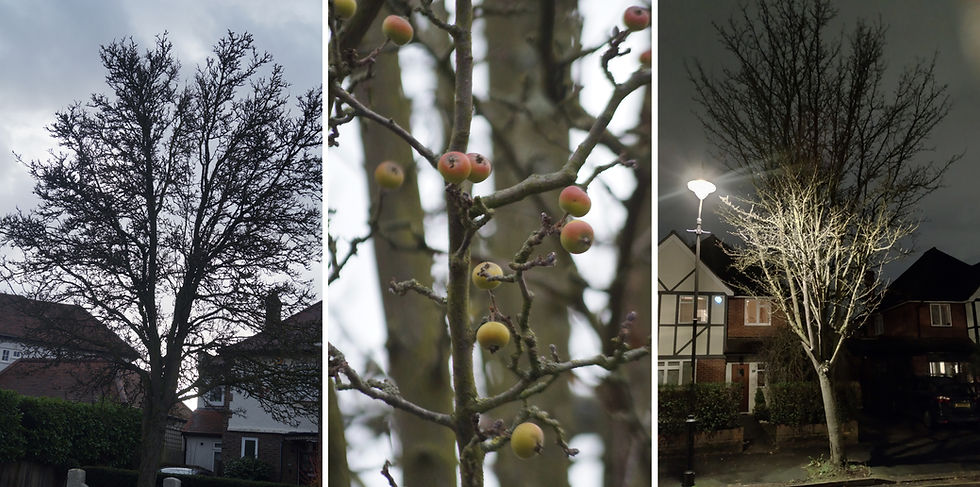
Fastigiate and columnar trees
Southwark has recently been planting a lot of trees in Herne Hill with a very erect habit. They take up less space than conventional forms and might not damage the pavements as much, but on the downside they won't be much use in providing shade during our blisteringly hot summers.
There's sometimes very little apparent difference between a tree labelled 'columnar', another called 'fastigiate' and one that doesn't have either title but is still very narrow, like some some cherries. We've got all of these in Herne Hill.
On the same stretch of Burbage Road as the chonosuki apple is a new arrival, a columnar Norway maple (Acer platanoides ‘Columnare’), planted in December at no 15. Half a dozen doors away at no. 3 is this very tall, straight and narrow white-barked birch, probably an upright Himalayan birch (Betula utilis 'Fastigiata').
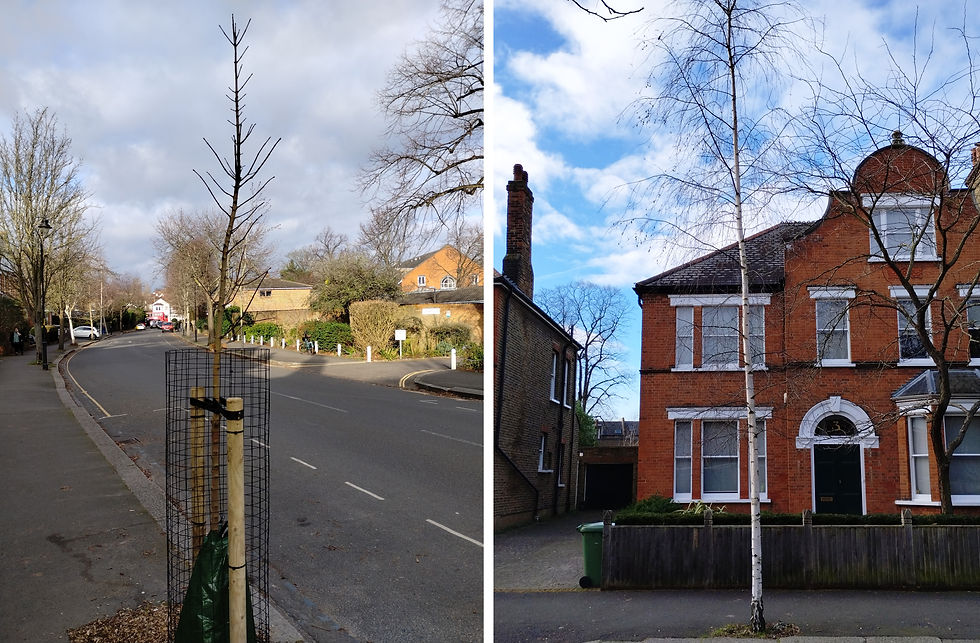
The pair of aspens on Casino Avenue, at the junction with Red Post Hill, are also very slender, possibly the cultivar called Populus tremula 'Erecta'. The tree in the first photo below is outside no. 114 Casino, and its twin is diagonally opposite at 115. They were planted exactly three years ago.
Just around the corner on Casino, towards the stop for the 42 and P4 buses, stands the cypress oak (Quercus robur fastigiata 'Koster') whose clustered buds we looked at earlier. And outside Bessemer Grange on Nairne Grove, in the traffic island where it meets Woodfarrs, is a recently planted fastigiate oriental beech (Fagus orientalis 'Iskander') with near-vertical twigs and branches.

Returning to Danecroft Road, here are the winter profiles of the fastigiate trees planted in December 2022 that we've already mentioned. The bastard service tree pictured is outside nos. 55-57, while the two other service trees are both at the bottom of the road, one alongside the rear garden of 14b Elmwood and the other at the back of 12 Elmwood. The solitary hornbeam (Carpinus betulus 'Fastigiata') is up near the junction with Herne Hill, on the even side of the street.

Winter bark
The bark can be a very useful key to the identity of street trees in winter, but it can take years for it to become rugged, cracked or distinctively patterned and to take on its mature colour. Newly planted trees are almost always smooth-barked, which can make an accurate identification difficult, even when using one of the many phone apps.
But there's one local tree that makes it easy for us: the Styphnolobium japonicum or Japanese pagoda tree (formerly classified as the Sophora japonica). It's an attractive, fast-growing tree, drought-tolerant and shade-giving, and there are several on Holmdene Avenue.
The one on the left, at 74-76 Homdene, dates from December 2022. It's got the distinctive smooth, grey-green bark with white lenticels (pores) of a juvenile pagoda tree. The older one on the right, planted in February 2021 at the bottom of the road beyond no. 96, has the rough, pale brown stem of a mature tree - but the more recently formed branches are grey-green again. You see this even in much older specimens: one colour for the trunk, and another for new growth up in the crown.
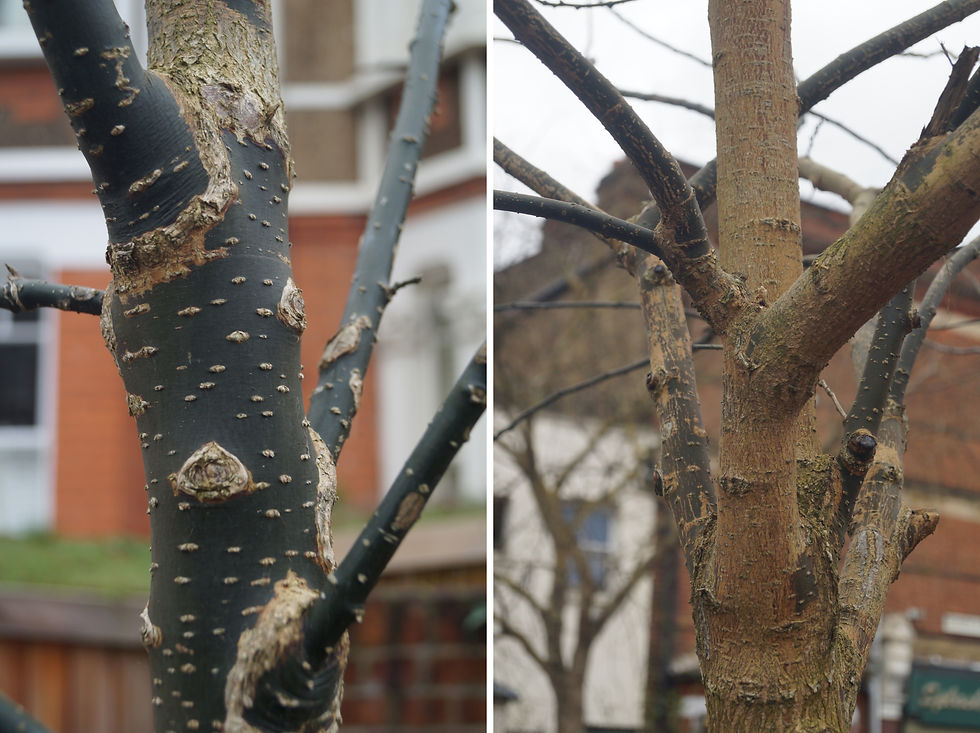
You shouldn't have any trouble naming a London plane (Platanus x hispanica), by far the biggest and commonest tree on our streets. Even without the large maple-shaped leaves or the dangling pom-pom brown fruit, the peeling bark is a giveaway, with its patchwork of grey, brown and yellow. But in our summers of heat and drought the bark peels away in sheets, leaving the trunk austerely white, like this plane at 51 Half Moon Lane.
If you want to see the natural habit of London planes you should head over to Sunray Avenue, where most of the huge trees lining the road have never been interfered with by tree surgeons. On Half Moon Lane, though, their form has been carefully engineered to restrict their growth and let the double-deckers go past.
First the main limbs are pollarded, in other words lopped abruptly. The warty burrs that develop at the cut then have to be trimmed at least once a year to maintain the shape and promote rapid new growth. The arborists were steadily making their way along the street in January, giving each plane a neat haircut, ready for spring.
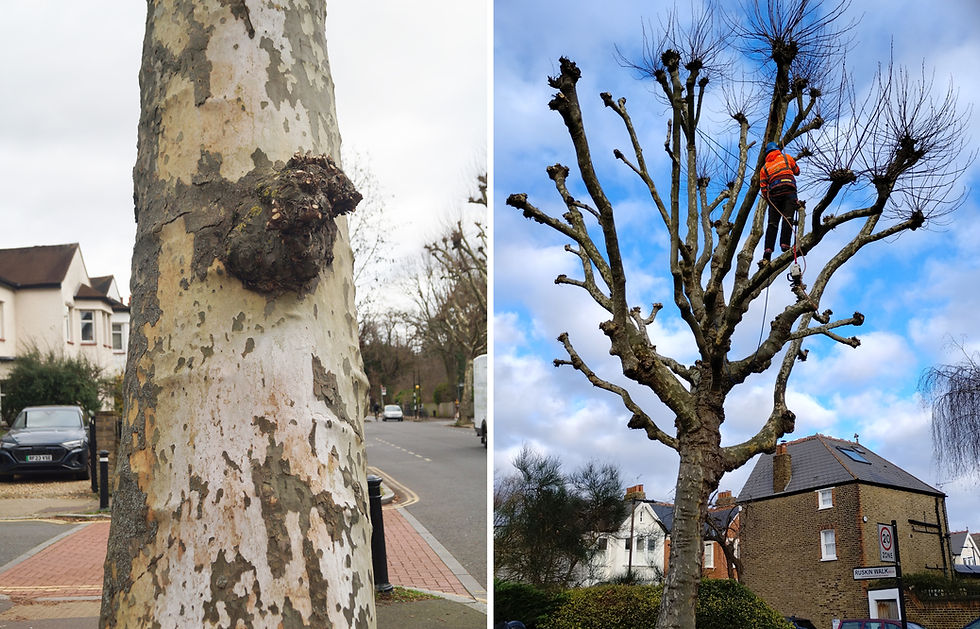
Commenti